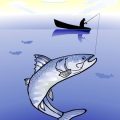Introduction to Walleye Fishing in the US
Walleye fishing holds a special place in the hearts of anglers across the United States. Whether you’re casting your line from a sleek bass boat on a sprawling Midwestern lake or staking out your favorite spot along the rocky shoreline, chasing walleye is more than just a pastime—it’s a tradition. The allure of walleye comes not only from their elusive nature and spirited fight but also from their reputation as one of the tastiest freshwater fish around. This widespread appeal means that both beginners looking for their first catch and seasoned anglers seeking trophy fish find common ground in walleye fishing. From the Great Lakes to rivers in the Dakotas and reservoirs down South, each region offers unique opportunities and challenges, prompting ongoing debates about whether boat or shore fishing reigns supreme. Understanding these differences is key to making the most out of every trip and maximizing your chances of landing that perfect walleye.
2. Boat Fishing for Walleye: Pros and Cons
If you’re serious about catching walleye, fishing from a boat opens up a whole new world of opportunities. Let’s dive into the specific pros and cons of boat fishing so you can decide if it’s the right approach for your next outing.
Pros of Boat Fishing for Walleye
One of the biggest advantages to fishing from a boat is mobility. You’re able to cover much more water compared to shore anglers. This means you can follow schools of walleye as they move throughout the day, or quickly relocate if your current spot isn’t producing bites. Boats also allow access to deeper water where bigger walleyes often hang out, especially during the heat of summer or in early spring when theyre less likely to be near shore.
| Advantage | Description |
|---|---|
| Mobility | Easily change locations and adapt to fish movement. |
| Access to Deeper Water | Reach spots that are impossible from shore, targeting larger fish. |
| Variety of Techniques | Troll, jig, or use electronics for precise targeting. |
| Less Crowded | Avoid crowded banks and enjoy more personal space. |
Cons of Boat Fishing for Walleye
However, there are some downsides to consider. First off, owning or even renting a boat can be expensive—not just upfront, but also ongoing costs like fuel, maintenance, insurance, and storage. There’s also extra logistics involved: launching, trailering, cleaning, and keeping safety gear on hand. On busy weekends or at popular lakes, finding parking or waiting your turn at the ramp can eat into your fishing time. Additionally, weather conditions may limit your ability to get out safely on certain days.
| Drawback | Description |
|---|---|
| Cost | Boat purchase/rental plus maintenance and storage fees. |
| Logistics | Requires planning for transport, launch, and safety measures. |
| Weather Dependency | Windy or stormy days can make boating unsafe or uncomfortable. |
| Learning Curve | Takes time to master boat handling and electronic equipment. |
Is Boat Fishing Right for You?
If maximizing your chances for trophy walleye is your goal—and you don’t mind investing in gear and preparation—boat fishing offers clear advantages. Just weigh those benefits against the financial commitment and extra effort required before making the leap.
![]()
3. Shore Fishing for Walleye: Pros and Cons
Shore fishing for walleye is a classic approach that draws anglers of all skill levels, especially those looking for an accessible and cost-effective way to hit the water. One of the biggest benefits is accessibility—almost anyone can grab a rod, pick a local lake or riverbank, and start fishing without needing a boat or pricey gear. This makes shore fishing budget-friendly, as you avoid expenses like boat maintenance, fuel, and launch fees. Plus, it’s easy to fit into your schedule; you can fish after work or on weekends without much planning.
However, there are trade-offs to consider. Your reach is naturally limited from the shoreline, so you might miss out on deeper structures or prime walleye spots that boats can access easily. Popular public areas can get crowded during peak times, which sometimes means less elbow room and more competition for the best spots. Also, your presentation options are somewhat restricted—you’re often casting straight out rather than working an area thoroughly from multiple angles.
Despite these limitations, shore fishing shines in certain scenarios. Early spring and late fall often bring walleye close to shorelines to feed, making these times especially productive for land-based anglers. By adapting your tactics—like using long casts, targeting inflows and rocky points, and adjusting bait choices—you can maximize your success even with these constraints.
4. Gear and Techniques: Boat vs. Shore Tactics
Choosing the right gear and mastering the best techniques are critical for walleye anglers, whether you’re casting from a boat or working the shoreline. Each approach requires its own set of tools and tactics to maximize your chances of landing fish. Here’s a breakdown of recommended rods, reels, lures, and proven methods for both boat and shore walleye fishing.
Boat Fishing Gear & Best Practices
| Category | Recommended Setup |
|---|---|
| Rod | 6’6”–7’ medium-light to medium spinning rod with fast action tip for sensitivity |
| Reel | 2500–3000 size spinning reel with smooth drag (braided line compatible) |
| Main Line | 8–12 lb braided line for casting distance and sensitivity; fluorocarbon leader (6–10 lb) for stealth |
| Lures/Presentations | Jig heads with soft plastics, live bait rigs, crankbaits, bottom bouncers, trolling harnesses |
| Tactics | Trolling at different depths, vertical jigging over structure, drifting along drop-offs, using electronics to locate schools |
Best Practices for Boat Anglers
- Use sonar and GPS to target walleye-holding structure like humps, weed edges, and points.
- Change lure colors and sizes based on water clarity and light conditions.
- Troll or drift slowly to cover ground but keep your presentation in the strike zone.
- Always check local boating regulations and safety protocols.
Shore Fishing Gear & Best Practices
| Category | Recommended Setup |
|---|---|
| Rod | 7’–8’ medium spinning rod for longer casts and line control from shorelines or piers |
| Reel | 2500 size spinning reel with quality drag system (monofilament friendly) |
| Main Line | 8–10 lb monofilament for forgiveness on snags and rocks; optional fluorocarbon leader (6–8 lb) |
| Lures/Presentations | Slim profile crankbaits, slip bobber rigs with live minnows or leeches, small jigs tipped with plastics or bait, blade baits for current areas |
| Tactics | Casting parallel to shorelines at dawn/dusk, working eddies near current breaks, fishing under bridges or near inflowing streams after rain events |
Best Practices for Shore Anglers
- Arrive early or stay late—walleye often feed close to shore during low-light periods.
- Pocket tackle is key: bring a small selection of versatile lures and extra leaders/hooks.
- Avoid spooking fish by keeping noise and movement minimal along the bank.
- If possible, scout locations during daylight to identify underwater structure or drop-offs accessible from shore.
5. Top Tips for Success Regardless of Method
Whether you’re casting from the shoreline or drifting on a boat, there are several actionable strategies that can help you maximize your walleye catch rates. Here’s what works across both approaches, with a focus on adapting to seasonal patterns and staying safe on the water or land.
Master Seasonal Patterns
Spring: As water temperatures rise, walleye move into shallower areas to spawn. Focus your efforts near rocky shorelines, river mouths, or shallow flats—prime locations whether you’re in a boat or fishing from shore. Use lighter jigs and live bait rigs for best results.
Summer: Walleye often retreat to deeper, cooler waters during hot months. Boaters should use sonar to locate underwater structures and drop-offs, while shore anglers can target shaded banks or fish at dawn and dusk when walleyes come closer to feed. Consider crankbaits or slip bobber rigs with leeches.
Fall: Cooling temperatures trigger active feeding. Both shore and boat anglers should look for baitfish schools and use minnow-based lures or live minnows. Fish move shallower again, so don’t overlook classic shoreline spots or weed edges.
Use the Right Tackle and Bait
No matter where you fish, match your tackle to the conditions. Lighter lines (6-10 lb test) offer better sensitivity for subtle bites. Choose jig sizes based on current and wind conditions—heavier jigs for fast water or windy days, lighter ones for calm settings. Live bait like nightcrawlers, leeches, or minnows almost always outperform artificial baits, especially in tough conditions.
Adapt Your Presentation
Vary your retrieval speed and presentation style until you find what triggers strikes. In clear water, slow down and use natural colors; in murky water, opt for brighter lures and more aggressive movement. Don’t be afraid to experiment with vertical jigging from a boat or casting parallel to the shoreline when fishing from land.
Stay Safe and Be Prepared
Safety is non-negotiable. Always wear a life jacket when boating—even if you’re an experienced angler—and double-check weather forecasts before heading out. For shore fishing, watch your footing on wet rocks and bring a first-aid kit along with plenty of drinking water. Let someone know where you’ll be fishing, no matter your method.
Final Pro Tip
The most successful walleye anglers are flexible—willing to try new spots, switch up tactics, and learn from each trip. Track your results in a journal to identify patterns over time. Whether you prefer the mobility of a boat or the accessibility of shoreline fishing, being observant and adaptable will help you put more walleyes in the net all season long.
6. Choosing What’s Best for You
When it comes to walleye fishing, the decision between boat and shore angling isn’t one-size-fits-all. Your choice should align with your fishing goals, lifestyle, budget, and even your local waters. Here’s a practical guide to help you make the best call.
Identify Your Fishing Goals
If you dream of exploring vast reservoirs or targeting walleyes on open water structures, a boat offers unmatched mobility and access. Boating is ideal if you want to chase trophy fish or enjoy fishing with family and friends in comfort. On the flip side, shore fishing delivers plenty of action during peak seasons—especially spring and fall—and connects you with nature at a more relaxed pace. It’s perfect for spontaneous trips or quick after-work sessions.
Consider Your Lifestyle & Budget
Let’s be honest: boats require a significant investment—not just for the vessel itself, but also for maintenance, storage, fuel, insurance, and permits. If you have the resources and love tinkering with gear, boating might be a great fit. Shore anglers need only basic tackle, a valid license, and good shoes. If you value simplicity or are just starting out, shore fishing keeps things affordable and flexible.
Local Insight: American Hotspots
In the Midwest—think Minnesota’s Mille Lacs Lake or Michigan’s Saginaw Bay—boaters can take advantage of vast waters teeming with walleyes. However, many public piers and riverbanks offer excellent shore access, especially during walleye runs. Out West on places like Lake McConaughy (Nebraska) or Columbia River (Washington/Oregon), both methods thrive depending on season and weather. In the Great Lakes region (Lake Erie is legendary), boaters often reach deeper schools in summer while shoreline anglers clean up in spring when fish move shallow to spawn.
Pro Tip: Try Both Before You Commit
If you’re undecided, consider renting a boat or joining a guided trip before investing. Likewise, explore top-rated public access points near home—you might be surprised by what you catch from shore! Many seasoned anglers keep both options open for different seasons or moods.
The Bottom Line
Your best bet is to match your fishing style with what brings you joy and fits your reality. Whether you’re launching from a shiny bass boat or casting off a quiet dock, walleye fishing has something special to offer everyone across America’s lakes and rivers.


